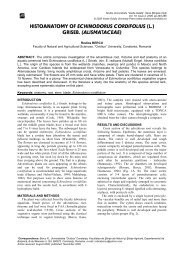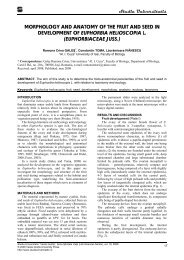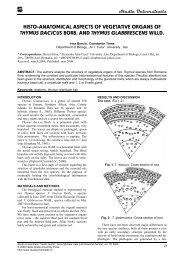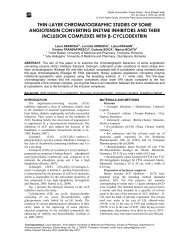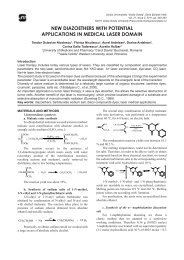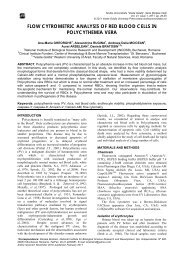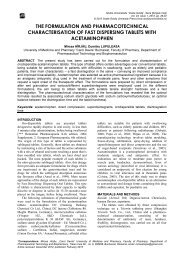Read full article - Studia Universitatis Vasile Goldis, Seria Stiintele ...
Read full article - Studia Universitatis Vasile Goldis, Seria Stiintele ...
Read full article - Studia Universitatis Vasile Goldis, Seria Stiintele ...
You also want an ePaper? Increase the reach of your titles
YUMPU automatically turns print PDFs into web optimized ePapers that Google loves.
A comparative analysis of the histological structure of the aerial organs<br />
of plants grown on sterile heaps and respectively in ordinary soil<br />
Fig. 13 Plantlet of dried out Robinia pseudacacia L. on<br />
the southern side of the Săsar sterile heap<br />
CONCLUSIONS<br />
Considering the things we have presented above,<br />
we can say that:<br />
1. Robinia pseudacacia L., is a very resistant<br />
species to the environment factors, including the ones<br />
from the sterile heaps. There exist certain alterations on<br />
the sterile substratum, however they are not very<br />
ample, and above all not significant enough to prevent<br />
the species to grow in these areas. The acumulation of<br />
pollutants in this plant does, of course, hinder its<br />
development, however,even if its size and even its<br />
vigour are smaller than in normal substratum, this<br />
species qualifies itself very well for becoming an<br />
important element in the settling of the ground and<br />
regenerating of the soil on the sterile heaps, especially<br />
after it has been placated with phyto-soil.<br />
Of course, as one can see, Robinia pseudacacia L<br />
is sensitive to certain conditions. Thus, when planted<br />
on the southern side of the hill, in <strong>full</strong> sun, and on a<br />
steep slope, which does not retain water, the plants<br />
went dry pretty soon (Fig.13); but when planted on the<br />
northern or western side, or on less steep slopes, which<br />
retain more water (although the sterile maintains a high<br />
degree of moist), this plant grew very well, rooted<br />
well-enough not to be blown down by the wind, grew<br />
enough foliage, which through putrefaction contributed<br />
to the forming of soil,be that rather slowly, indeed.<br />
The species is present on all the sterile heaps in the<br />
Baia-Mare Depression (including the one in Bozânta),<br />
growing better when planted in areas with more moist<br />
and slopes not too steep, and with less exposure to the<br />
sun. This plant can reach in such areas a good<br />
development (even for normal soils), such as the northwestern<br />
side of the sterile heap in Sasar, but its use as<br />
melliferous plant is very limited, even negligible in<br />
droughty conditions, because of the polluting dust<br />
which sets down on the leaves (Fig.5), and which sends<br />
away the bees or even kills them if the dust sets on the<br />
flowers during a droughty period when the plants are<br />
blooming. Rain may wash away at least some of the<br />
dust, even to the point at which the bees can work.<br />
<strong>Studia</strong> <strong>Universitatis</strong> “<strong>Vasile</strong> Goldiş”, <strong>Seria</strong> Ştiințele Vieţii<br />
Vol. 19, issue 1, 2009, pp. 171-176<br />
© 2009 <strong>Vasile</strong> <strong>Goldis</strong> University Press (www.studiauniversitatis.ro)<br />
These are the main reasons why all the sterile heaps, at<br />
least in the Bia-Mare Depression have Robinia<br />
pseudacacia L., as main arboricolous fixing element.<br />
Even though on smaller areas can be seen Populus<br />
alba L., Populus nigra L., Populus tremula L.,<br />
Quercus petraea (Mattuschka) Liebl., Quercus robur<br />
L., and even Castanea sativa Miller (Castanea vesca<br />
Gärtn.), the acacia remains by far the most widespread,<br />
and the most constant plant on the sterile heaps.<br />
To conclude with, Robinia pseudacacia L. is a<br />
species which, even though on the sterile heaps has a<br />
growth which is hindered, as compared to normal, this<br />
plant easily adapts itself to settle and regenerate the soil<br />
on the sterile heaps, the histological alterations being<br />
insignificant for the development of the plants.<br />
2. The Centaurea genus is well-represented on the<br />
sterile heaps (especially on the one in Săsar), but has a<br />
low degree of coverage due to the rare distribution of<br />
the plants. Centaurea cyanus L. is a species which, as<br />
we have shown above is not greatly affected by the<br />
sterile substratum, but then, it can neither be<br />
considered essential for the forming of soil directly on<br />
the sterile, at least because of its reduced density.<br />
However, after a previous placating of the heaps with<br />
phyto-soil in a thin layer, Centaurea cyanus L. might<br />
help a lot to cut down on the cost of ecologising, as it is<br />
a true settler of soil, at least till the natural development<br />
of other species of plants.<br />
3. Out all the species dealt with in this paper,<br />
Polygonum cuspidatum Sieb. et Zucc. (Reynoutria<br />
japonica Houtt.) is the one that is least affected by<br />
what kind of sterile substratum it grows on, and this is<br />
why it may be considered as a pioneer of vegetal<br />
expansion on the sterile heaps, and mainly in the<br />
farming fields in the area. Although the species is<br />
recognised as being spread at the level of Romania<br />
mainly in Maramures (V. Ciocârlan, 2000), it grows on<br />
the sands in the north-west of the country (G. Ardelean,<br />
C. Karácsonyi, 2005), up to the Ieru valley (G.<br />
Ardelean, C. Karácsonyi, 2002), but cannot be found<br />
south of the Bihor County (A. Ardelean, 2006). This<br />
plant was initially cultivated to be eaten and as<br />
ornament, but it spread and grew wild, covering larger<br />
and larger expanses of land, without the intervention of<br />
man, who tried then to reduce its expansion because it<br />
was threatening the cultivated plants. Polygonum<br />
cuspidatum Sieb. et Zucc. (Reynoutria japonica<br />
Houtt.) can be grown either after rooting, or directly as<br />
cuttings, even in sterile substratum, but, if only a very<br />
thin layer of soil is used, through its rich network of<br />
roots, it fixes the soil very well, and the rich foliage<br />
consistently contributes to the generating of new soil.<br />
Taking into account everything we have stated above,<br />
we can conclude that Polygonum cuspidatum Sieb. et<br />
Zucc. (Reynoutria japonica Houtt.) is a species that<br />
might become one of the biological materials that can<br />
be used for settling and ecologising the sterile heaps.<br />
175



